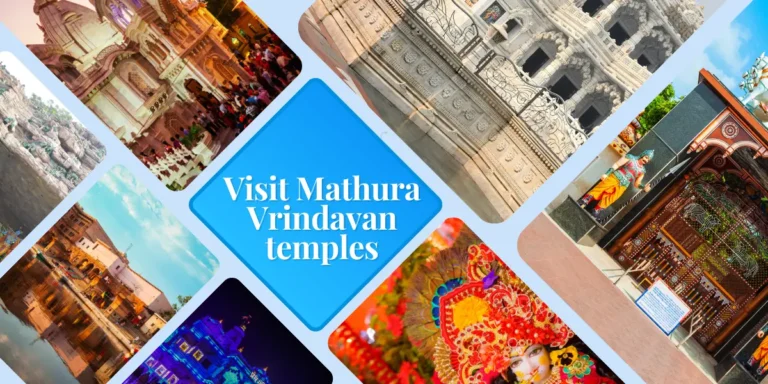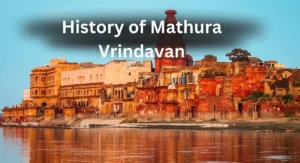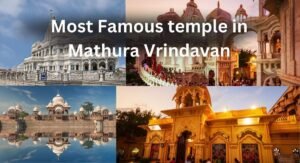Welcome to the enchanting world of Vrindavan, a town that resonates with the divine love of Lord Krishna and Radha. Whether you type “Vrindavan,” “vrundavan,” or “virndavan” into your search bar, you’re likely seeking the same sacred destination—a place nestled in the Mathura district of Uttar Pradesh, India. These variations—common misspellings or phonetic searches—lead countless devotees and travelers to this spiritual haven every year. Vrindavan isn’t just a dot on the map; it’s a living testament to Krishna’s playful pastimes, a pilgrimage site brimming with ancient temples, vibrant festivals, and an atmosphere that feels like a step into divinity. In this blog, we’ll take you on a 2000-word journey through Vrindavan’s history, significance, iconic temples, joyous celebrations, and practical travel tips, all while weaving in the essence of “vrundavan” and “virndavan” naturally. For more insights, feel free to explore our website at Mathura Vrindavan temples.
Table of Contents
ToggleThe Timeless History of Vrindavan
Vrindavan’s story begins in the realm of mythology, deeply rooted in the life of Lord Krishna. According to Hindu scriptures, this is where Krishna spent his childhood, enchanting the gopis (milkmaids) with his flute and performing leelas—divine acts that still echo through the town’s lanes. The name “Vrindavan” comes from “Vrinda,” another name for the sacred Tulsi plant, and “van,” meaning forest, hinting at its lush, green origins. Many who search for “vrundavan” or “virndavan” might not realize that this town’s history stretches back thousands of years, with some temples believed to be over 5,000 years old.
Legend has it that Vrindavan was rediscovered in the 16th century by Chaitanya Mahaprabhu, a revered saint who identified sacred sites linked to Krishna’s pastimes. But its roots go deeper—archaeological finds suggest habitation since ancient times, possibly from the Gupta period. One beloved tale is the Ras Lila, where Krishna danced with the gopis under a moonlit sky. Today, this divine dance lives on in cultural performances across Vrindavan, captivating visitors with its grace.
The town is also dotted with kunds (holy ponds) like Brahma Kund, where Lord Brahma is said to have bathed after testing Krishna’s divinity, and Radha Kund, linked to Radha’s devotion. These stories and sites make Vrindavan a treasure trove of history and faith, drawing pilgrims who seek to walk where Krishna once played.
Why Vrindavan Holds a Special Place in Hearts
Vrindavan is more than a destination—it’s a spiritual experience. For followers of Vaishnavism, it’s one of India’s holiest places, believed to be imbued with Krishna’s presence. Devotees say the very dust of Vrindavan is sacred, capable of cleansing sins and uplifting the soul. Whether you’re searching for “Vrindavan,” “vrundavan,” or “virndavan,” you’re tapping into a quest for peace and connection with the divine.
The town’s spiritual energy is palpable. The sound of temple bells, the chanting of “Hare Krishna,” and the fragrance of incense create an ambiance that feels otherworldly. Pilgrims visit to meditate, pray, and participate in rituals, believing that time spent here brings them closer to liberation. It’s not uncommon to hear a devotee say, “Stepping into Vrindavan feels like coming home,” a sentiment that captures its profound significance.
Beyond religion, Vrindavan’s universal appeal lies in its message of love and devotion, embodied in the bond between Krishna and Radha. This timeless tale resonates with people of all backgrounds, making Vrindavan a place where spirituality transcends boundaries.
Iconic Temples That Define Vrindavan
Vrindavan’s soul lies in its temples, each a masterpiece of devotion and architecture. Let’s explore some of the most iconic ones that draw visitors from near and far. For a deeper dive into these sacred sites, check out Mathura Vrindavan temples.
Banke Bihari Temple
The Banke Bihari Temple is a crown jewel of Vrindavan, famous for its stunning idol of Krishna in a tribhanga (three-fold bending) pose. Founded by Swami Haridas, this temple is alive with devotion, especially during the “Jhulan Yatra,” when the deity swings on a decorated jhula (swing) during the monsoon. The curtain before the idol opens and closes intermittently, a tradition to protect devotees from being overwhelmed by Krishna’s divine gaze.
Radha Raman Temple in Vrindavan
Another gem is the Radha Raman Temple, established by Gopala Bhatta Goswami. It houses a self-manifested idol of Krishna that emerged from a shaligram shila—a miracle that still inspires awe. The temple’s strict worship standards and the annual “Snana Yatra” (ceremonial bath of the deity) make it a must-visit.
ISKCON Temple in Vrindavan
The Krishna Balaram Mandir, better known as the ISKCON Temple, is a global hub for Krishna devotees. With its beautiful deities of Krishna and Balaram, and statues of ISKCON’s founder, A.C. Bhaktivedanta Swami Prabhupada, it’s a place of vibrant kirtans (devotional songs) and international camaraderie.
Prem Mandir in Vrindavan
A modern marvel, Prem Mandir is a white-marble wonder adorned with carvings of Krishna’s life. At night, its illuminated façade creates a breathtaking spectacle, symbolizing the eternal love between Radha and Krishna.
These temples, among hundreds of others, make Vrindavan a paradise for spiritual seekers. Whether you’re exploring “vrundavan” or “virndavan” online, these sacred spaces are what define this holy town.
Festivals That Bring Vrindavan to Life
Vrindavan’s festivals are a celebration of faith, color, and community. The town transforms during these events, offering a glimpse into its vibrant soul.
Holi: The Festival of Colors
Holi in Vrindavan is legendary. Devotees reenact Krishna’s playful throwing of colors on the gopis, drenching the streets in hues of red, yellow, and green. The air fills with songs like “Holi Khele Raghuveera,” and temples host grand celebrations. A visitor once shared, “It felt like Krishna himself was playing with us—pure joy!”
Janmashtami: Krishna’s Birthday
Janmashtami, marking Krishna’s birth, is a midnight extravaganza. Temples are adorned with flowers, and devotees fast until midnight, then celebrate with singing, dancing, and dramas depicting Krishna’s life. The Banke Bihari Temple buzzes with energy as crowds chant in unison.
Radhashtami: Radha’s Day
Radhashtami honors Radha, Krishna’s beloved. The day is quieter but deeply reverent, with processions and offerings at temples like Radha Raman. It’s a time to celebrate the divine feminine and her eternal bond with Krishna.
These festivals turn Vrindavan into a living canvas of devotion, attracting those who search for “vrundavan” or “virndavan” to experience this magic firsthand.
Travel Tips for Your Vrindavan Adventure
Planning a trip to Vrindavan? Here’s everything you need to know to make it unforgettable.
How to Reach Vrindavan
Vrindavan is easily accessible. The nearest railway station, Mathura Junction, is 10 km away, connected to major cities like Delhi and Agra. From there, take a taxi or auto-rickshaw. The closest airport is in Agra (60 km), or you can fly into Delhi (150 km) and drive down.
Best Time to Visit Vrindavan
Visit between October and March for pleasant weather—perfect for temple hopping and outdoor exploration. Summers are scorching, and monsoons bring heavy rains, though the lush greenery during July to September has its charm.
Where to Stay in Vrindavan
Options abound:
- Budget: Guesthouses and dharamshalas like MVT Guesthouse offer simple stays with vegetarian meals.
- Luxury: Nidhivan Sarovar Portico provides modern comforts near the temples.
- Ashrams: Many offer affordable lodging for pilgrims.
What to Eat
Vrindavan’s vegetarian cuisine is divine. Try aloo puri, kachori, and the iconic peda—a sweet prasad from temples. Street stalls and temple kitchens serve fresh, flavorful dishes that reflect the town’s sanctity.
Tips for Visitors
- Dress modestly, especially in temples.
- Carry cash—small vendors may not accept cards.
- Join the Vrindavan Parikrama, a 10 km walk around sacred sites, for a soulful experience.
The Natural Beauty of Vrindavan
Beyond its temples, Vrindavan’s natural allure captivates. The Yamuna River flows nearby, offering serene boat rides at sunset. Gardens and groves, like Nidhivan—where trees are said to dance at night—recall the forests of Krishna’s time. Walking the Parikrama path, you’ll feel the tranquility that makes Vrindavan a retreat from the world.
Some frequently asked questions on Vrindavan.
- What is the correct spelling: Vrindavan, vrundavan, or virndavan?
The official spelling is “Vrindavan,” but “vrundavan” and “virndavan” are popular misspellings due to how people hear or type the name. No matter the variation, it’s the same holy town in Uttar Pradesh, India! - Why do people search for “vrundavan” or “virndavan” instead of “Vrindavan”?
These misspellings often come from phonetic confusion or typing errors. Locals and tourists alike might hear “Vrindavan” spoken and guess the spelling, leading to searches like “vrundavan” or “virndavan.” - What are the must-visit temples in Vrindavan?
Don’t miss Banke Bihari Temple, Radha Raman Temple, ISKCON Vrindavan, and Prem Mandir. Each one offers a unique spiritual vibe and a peek into Krishna’s divine legacy. - How can I plan a trip to Vrindavan?
Pick a good time (like October to March), book a hotel near the temples, and map out key spots like temples and ghats. Add some local chaat tasting for the full experience—our blog has all the details! - What’s the best time to visit Vrindavan?
October to March is ideal for cool weather, but if you’re typing “vrundavan” or “virndavan” during Holi or Janmashtami, you’re in for a wild, colorful celebration worth the crowds. - Are there special festivals in Vrindavan?
Absolutely! Holi here is legendary—think colors flying everywhere—and Janmashtami celebrates Krishna’s birth with music and dance. Radhashtami is another gem you can’t miss. - Why is Vrindavan so important in Hindu mythology?
It’s where Lord Krishna grew up, playing tricks and stealing hearts. Known as his playground, Vrindavan is a spiritual hotspot for devotees seeking peace and connection. - How do I reach Vrindavan from big cities in India?
Take a train to Mathura Junction (just 10 km away) or fly into Agra (60 km) or Delhi (150 km), then hop in a taxi or auto-rickshaw. It’s super accessible for a pilgrimage! - What should I wear when visiting Vrindavan temples?
Go modest: kurtas or dhotis for men, sarees or salwar kameez for women. Skip the shorts and tank tops to respect the sacred vibes of this holy town. - Is Vrindavan safe for solo travelers?
Yes, it’s welcoming and safe, even for solo women travelers. The pilgrim-friendly atmosphere is a plus—just stay in busy areas at night and follow basic travel smarts.
Conclusion: A Call to Experience Vrindavan
Vrindavan is a tapestry of history, spirituality, and celebration. Whether you’re drawn by the temples, the festivals, or the promise of peace, this town delivers an experience like no other. The next time you search for “vrundavan” or “virndavan,” know that Vrindavan awaits with its timeless charm. Pack your bags, chant a prayer, and let this sacred land envelop you in its divine embrace. For more details on Mathura and Vrindavan’s treasures, visit Mathura Vrindavan temples.
Also Visit मथुरा से वृंदावन : एक आध्यात्मिक यात्रा |




